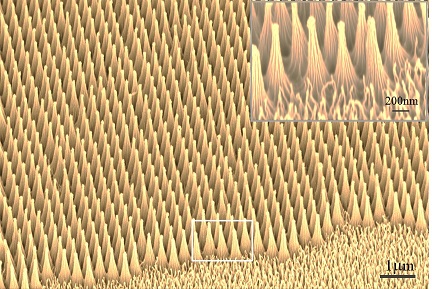
Caption:
The surface is a polymeric nanocone array that is generated by colloidal lithography, i.e. a masking of a polymeric substrate by nanoscale beads followed by a reactive ion etching. The inset shows more detailed structure to the individual nanocones which have 20nm ridges along their length.
Kyle Nowlin
Advisor: Dr. Dennis LaJeunesse
University of North Carolina Greensboro
Joint School of Nanoscience and Nanoengineering
Department of Nanoscience
Laboratory website: http://jsnn.ncat.uncg.edu
Technique: The image was acquired using a Zeiss Auriga SEM with the InLens detector and a 2keV electron beam.
Description:
Many insects display nanostructured surfaces (NSS) on their cuticles and many of these native NSS are inherently antimicrobial and kill microbes by mechanical/structure means. Our research explores the mechanisms that underlie the rupture of microbes on NSS. The native insect cuticles are complex materials that are difficult to replicate and to control specific surface properties. We have applied a colloidal lithographic process to generate novel synthetic NSS materials that resemble their biological insect cuticle counterparts in scale and shape but by using different polymeric materials to make these NSS can control surface properties of our biomimetic NSS. In this manner we will systematically identify the mechanical and physiochemical properties of rupturing NSS that lead to microbial demise. The goal of this research is to develop novel means of controlling the spread of pathogenic bacteria and fungi through nanostructured materials.
Funding Source: This work was supported by the North Carolina Biotechnology Center (NCBC) Biotechnology Research Grant and through the generous support of Dr. James Ryan, the Joint School of Nanoscience and Nanoengineering, and the State of North Carolina.


